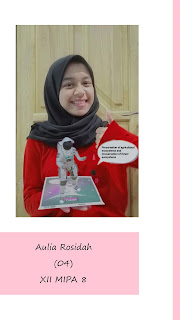Tugas Bahasa Inggris Aulia R. (04) 11 MIPA8
PERSONAL LETTER
Dear Sisca Thania.
Hello, This letter is the first time to talk to! It so awkward..! In fact, I do not speak English well.. kkk. Probably gonna be something messed up with the grammar. My school English scores only 80... And now I'm writing with a translator kkk. How is the weather there now? A few days ago is the end of the rainy season in Korea. Now it is hot! There is a fan next to me. Anyway, now I'm sad because tomorrow is Monday! I hate school! Why from 8.00 am to 5.00 pm we use to be at school?!
South Korea is a very deep for education. History, English, Science, Gigs, Art, Physical, Math, and so on... Oh there's not the point of this article. I'm sorry~ but these days, I feel so good! Because Seung Ri appear frequently on TV. Let's Talk About Love album and it's very good. I like his melodious voice. Now, this is the end of the letter. I hope the letter will arrive early there!
From : Seung Eun
2013.8.25. Sunday
CAUSE AND EFFECT
1. Food Coloring
- Cause : Purpose of giving color is so that the food looks more colorful so that, attracing the attention of consumer.
- Effect : The us of food Coloring can cause cancer, disorders of the kidneys and can also weaken the immune system.
2. Food Preservative
- Cause :
✓ Extend the shelf lige of food ingredients
✓Maintaining the physical and chemical properties off food ingredients
✓ Prevent or slow the rate of decomposition of food ingredients
✓ Prevent the growth of microbes that use fod as a to produce toxins in food
- Effect : Health problems such as difficuly breathing, throat disorders, nerve disorders to cancer
3. Flavoring
- Cause :
✓ Changing the aroma of the processe product with a particular aroma enhancer during processing
✓ Modifying, supplementing or enchaning aroma`s
✓ Cover or hide the aroma of food ingredients that are not preferred
✓ Froms new odors or neutralize when joining other components in food
- Effect :
✓Headache
✓ Excessive sweating
✓ Blood preasure
✓ Rigid facial skin
✓Chest pain
✓ Nausea
✓ Obesity
✓ Infertility
4. Hygienic (not healthy )
- Cause :
✓ Unclean environment
✓ Garbage piled up
✓ Many flies perched on food
- Effect
✓ Typhus
✓ Diarrhea
✓ Stomach ache
5. Food leftover
- Cause :
✓ Because the food is not tasty
✓ In a hury
✓ Stomach is full little time
-Effect
✓ Garbage builds up
✓ Bad smells
✓ Lots of flies
EXPLANATION TEXT
How Does an Earthquake Happen?
An earthquake is a shock wave that radiates to the Earth’s surface from underground. Causing a range of effects from unnoticeable, mild tremors to violent, prolonged shaking, an earthquake is a natural phenomenon that occurs frequently only in certain areas of the world. The place where an earthquake begins underground is called the hypocenter, and the area on the Earth’s surface directly above the hypocenter is called the epicentre and receives the most powerful shock waves.
Movement in the Earth’s crust causes an earthquake. The Earth is made of an inner core, an outer core, and a mantle, and the final layer is a thin crust covering the mantle, which is the surface of the Earth including all the oceans and continents. The crust is made of separate rocky portions called tectonic plates, which lie on the mantle like pieces of a jigsaw puzzle. But the jigsaw puzzle is mobile, and the plates move around. Some slide past each other horizontally, some push together and force the ground upward, some slide beneath another plate and some pull apart. Whenever a tectonic plate moves suddenly, this causes an earthquake.
The sudden release of friction and pressure between tectonic plates causes an earthquake. Tectonic plates are made of rough rock and cannot slide past each other smoothly. Friction prevents movement at the plate edges while the rest of the plates continue to move, causing a buildup in pressure. When the pressure overcomes the friction, the plates move suddenly, and shock waves from this sudden movement radiate through rock, soil, buildings, and water. Usually, small foreshocks occur at first, followed by one big mainshock. Aftershocks follow and can continue for weeks, months or even years.
Fault lines are the areas where two or more tectonic plates join, and it’s in these areas most earthquakes occur. Well-studied fault lines include the San Andreas Fault that runs down the West Coast of North America and lines between Australia and Papua New Guinea, as well as in New Zealand, Tonga, Japan, and Taiwan. Earthquakes can also rarely occur in the middle of tectonic plates. Scientists aren’t yet able to predict earthquakes, but people living near fault lines can help protect themselves by living in earthquake-protected housing and practising earthquake drills.
An earthquake damaged buildings and land causes tsunamis and has many other disastrous effects. Violent shaking from an earthquake collapses buildings, which causes the most deaths and casualties, and destroys power lines and ruptures natural gas supply lines, causing fires. Land can also collapse or pull apart, causing more buildings to fall. Tsunamis occur after an earthquake on the ocean floor. The water shock wave travels through the ocean until it dissipates or meets land. If the wave meets land, the water piles up, creating a single wave or a series of large waves that sweep inland, causing death and destruction.
Dear Sisca Thania.
Hello, This letter is the first time to talk to! It so awkward..! In fact, I do not speak English well.. kkk. Probably gonna be something messed up with the grammar. My school English scores only 80... And now I'm writing with a translator kkk. How is the weather there now? A few days ago is the end of the rainy season in Korea. Now it is hot! There is a fan next to me. Anyway, now I'm sad because tomorrow is Monday! I hate school! Why from 8.00 am to 5.00 pm we use to be at school?!
South Korea is a very deep for education. History, English, Science, Gigs, Art, Physical, Math, and so on... Oh there's not the point of this article. I'm sorry~ but these days, I feel so good! Because Seung Ri appear frequently on TV. Let's Talk About Love album and it's very good. I like his melodious voice. Now, this is the end of the letter. I hope the letter will arrive early there!
From : Seung Eun
2013.8.25. Sunday
CAUSE AND EFFECT
1. Food Coloring
- Cause : Purpose of giving color is so that the food looks more colorful so that, attracing the attention of consumer.
- Effect : The us of food Coloring can cause cancer, disorders of the kidneys and can also weaken the immune system.
2. Food Preservative
- Cause :
✓ Extend the shelf lige of food ingredients
✓Maintaining the physical and chemical properties off food ingredients
✓ Prevent or slow the rate of decomposition of food ingredients
✓ Prevent the growth of microbes that use fod as a to produce toxins in food
- Effect : Health problems such as difficuly breathing, throat disorders, nerve disorders to cancer
3. Flavoring
- Cause :
✓ Changing the aroma of the processe product with a particular aroma enhancer during processing
✓ Modifying, supplementing or enchaning aroma`s
✓ Cover or hide the aroma of food ingredients that are not preferred
✓ Froms new odors or neutralize when joining other components in food
- Effect :
✓Headache
✓ Excessive sweating
✓ Blood preasure
✓ Rigid facial skin
✓Chest pain
✓ Nausea
✓ Obesity
✓ Infertility
4. Hygienic (not healthy )
- Cause :
✓ Unclean environment
✓ Garbage piled up
✓ Many flies perched on food
- Effect
✓ Typhus
✓ Diarrhea
✓ Stomach ache
5. Food leftover
- Cause :
✓ Because the food is not tasty
✓ In a hury
✓ Stomach is full little time
-Effect
✓ Garbage builds up
✓ Bad smells
✓ Lots of flies
EXPLANATION TEXT
How Does an Earthquake Happen?
An earthquake is a shock wave that radiates to the Earth’s surface from underground. Causing a range of effects from unnoticeable, mild tremors to violent, prolonged shaking, an earthquake is a natural phenomenon that occurs frequently only in certain areas of the world. The place where an earthquake begins underground is called the hypocenter, and the area on the Earth’s surface directly above the hypocenter is called the epicentre and receives the most powerful shock waves.
Movement in the Earth’s crust causes an earthquake. The Earth is made of an inner core, an outer core, and a mantle, and the final layer is a thin crust covering the mantle, which is the surface of the Earth including all the oceans and continents. The crust is made of separate rocky portions called tectonic plates, which lie on the mantle like pieces of a jigsaw puzzle. But the jigsaw puzzle is mobile, and the plates move around. Some slide past each other horizontally, some push together and force the ground upward, some slide beneath another plate and some pull apart. Whenever a tectonic plate moves suddenly, this causes an earthquake.
The sudden release of friction and pressure between tectonic plates causes an earthquake. Tectonic plates are made of rough rock and cannot slide past each other smoothly. Friction prevents movement at the plate edges while the rest of the plates continue to move, causing a buildup in pressure. When the pressure overcomes the friction, the plates move suddenly, and shock waves from this sudden movement radiate through rock, soil, buildings, and water. Usually, small foreshocks occur at first, followed by one big mainshock. Aftershocks follow and can continue for weeks, months or even years.
Fault lines are the areas where two or more tectonic plates join, and it’s in these areas most earthquakes occur. Well-studied fault lines include the San Andreas Fault that runs down the West Coast of North America and lines between Australia and Papua New Guinea, as well as in New Zealand, Tonga, Japan, and Taiwan. Earthquakes can also rarely occur in the middle of tectonic plates. Scientists aren’t yet able to predict earthquakes, but people living near fault lines can help protect themselves by living in earthquake-protected housing and practising earthquake drills.
An earthquake damaged buildings and land causes tsunamis and has many other disastrous effects. Violent shaking from an earthquake collapses buildings, which causes the most deaths and casualties, and destroys power lines and ruptures natural gas supply lines, causing fires. Land can also collapse or pull apart, causing more buildings to fall. Tsunamis occur after an earthquake on the ocean floor. The water shock wave travels through the ocean until it dissipates or meets land. If the wave meets land, the water piles up, creating a single wave or a series of large waves that sweep inland, causing death and destruction.


Comments
Post a Comment